词汇学相关的一些名词解释
- 格式:docx
- 大小:20.04 KB
- 文档页数:8
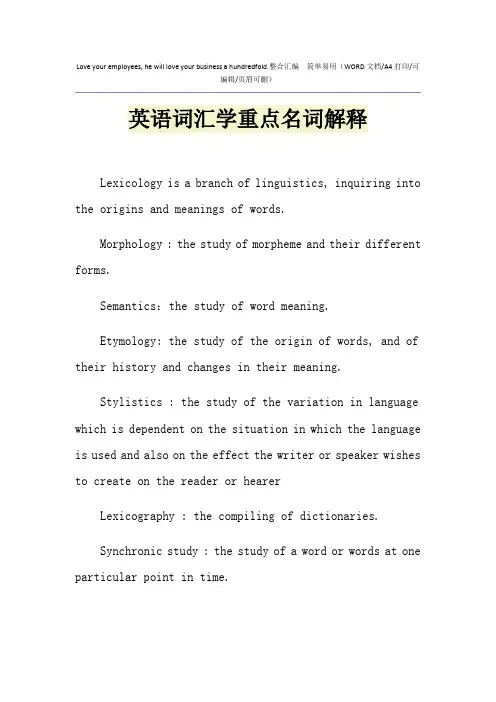
Love your employees, he will love your business a hundredfold.整合汇编简单易用(WORD文档/A4打印/可编辑/页眉可删)英语词汇学重点名词解释Lexicology is a branch of linguistics, inquiring into the origins and meanings of words.Morphology : the study of morpheme and their different forms.Semantics:the study of word meaning.Etymology: the study of the origin of words, and of their history and changes in their meaning.Stylistics : the study of the variation in language which is dependent on the situation in which the language is used and also on the effect the writer or speaker wishes to create on the reader or hearerLexicography : the compiling of dictionaries.Synchronic study : the study of a word or words at one particular point in time.Diachronic study: an approach to lexicology which studies how a word (or words) changes over a period of time. word: a word is a minimal free form of a language that has a given sound and meaning and syntactic function.vocabulary:Vocabulary refers to the total number of the words in a language, but it can stand for all the words used in a particular historical period.Vocabulary also refers to all the words of a given dialect, given book, a given disciplineand the words possessed by an individual person.Terminology术语 consists of technical terms used in particular disciplines and academic areas as in medicine: Jargon 行话refers to the specialized vocabularies by which members of particular arts, sciences, trades and professions communicate among themselves such as in business.slang 俚语belongs to the sub-standard language, a category that seems to stand between the standard general words including informal ones available to everyone and in-group wordsArgot黑话 generally refers to the jargon of criminals. Its use is confined to the sub-cultural groups, and outsiders can hardly understand it,Archaisms古词语 are words or forms that were once in common use but are now restricted only to specialized or limited use.《英语词汇学重点名词解释》全文内容当前网页未完全显示,剩余内容下一页查看。
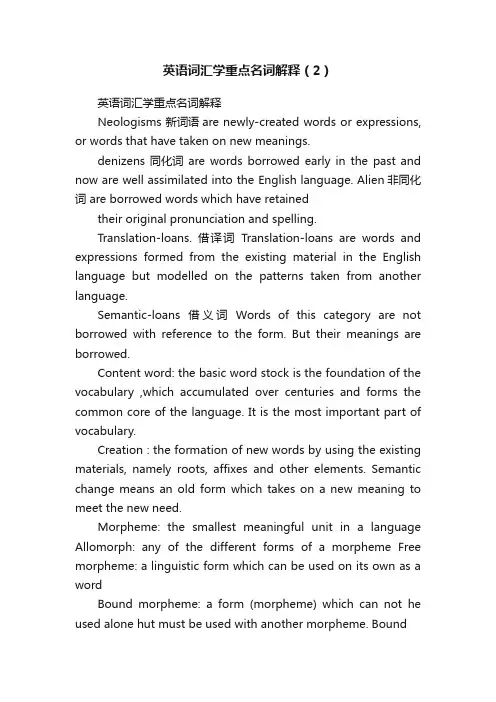
英语词汇学重点名词解释(2)英语词汇学重点名词解释Neologisms 新词语are newly-created words or expressions, or words that have taken on new meanings.denizens同化词are words borrowed early in the past and now are well assimilated into the English language. Alien非同化词 are borrowed words which have retainedtheir original pronunciation and spelling.Translation-loans. 借译词Translation-loans are words and expressions formed from the existing material in the English language but modelled on the patterns taken from another language.Semantic-loans借义词Words of this category are not borrowed with reference to the form. But their meanings are borrowed.Content word: the basic word stock is the foundation of the vocabulary ,which accumulated over centuries and forms the common core of the language. It is the most important part of vocabulary.Creation : the formation of new words by using the existing materials, namely roots, affixes and other elements. Semantic change means an old form which takes on a new meaning to meet the new need.Morpheme: the smallest meaningful unit in a language Allomorph: any of the different forms of a morpheme Free morpheme: a linguistic form which can be used on its own as a wordBound morpheme: a form (morpheme) which can not he used alone hut must be used with another morpheme. Boundmorphemes include hound roots and affixesAffixes: forms that are attached to words or word elements to modify meaning or functionPrefixation(suffixation): is the formation of new words by adding prefixes(suffixes) to stemInflectional affixes: affixes attached to the end of words to indicate grammatical relationshipsDerivational affixes: affixes added to other morphemes to create new wordsRoot: a morpheme which is the basic part of a word that can not be further analyzed without total loss of identity Stem: a form to which affixes of any kind can be added Bound root: a root that can not stand alone as a word Monomorphemic words: words that have nothing more than a free morpheme《英语词汇学重点名词解释》。
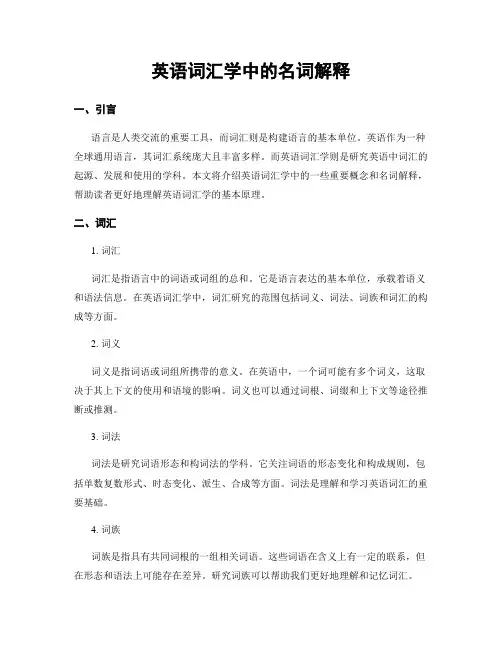
英语词汇学中的名词解释一、引言语言是人类交流的重要工具,而词汇则是构建语言的基本单位。
英语作为一种全球通用语言,其词汇系统庞大且丰富多样。
而英语词汇学则是研究英语中词汇的起源、发展和使用的学科。
本文将介绍英语词汇学中的一些重要概念和名词解释,帮助读者更好地理解英语词汇学的基本原理。
二、词汇1. 词汇词汇是指语言中的词语或词组的总和。
它是语言表达的基本单位,承载着语义和语法信息。
在英语词汇学中,词汇研究的范围包括词义、词法、词族和词汇的构成等方面。
2. 词义词义是指词语或词组所携带的意义。
在英语中,一个词可能有多个词义,这取决于其上下文的使用和语境的影响。
词义也可以通过词根、词缀和上下文等途径推断或推测。
3. 词法词法是研究词语形态和构词法的学科。
它关注词语的形态变化和构成规则,包括单数复数形式、时态变化、派生、合成等方面。
词法是理解和学习英语词汇的重要基础。
4. 词族词族是指具有共同词根的一组相关词语。
这些词语在含义上有一定的联系,但在形态和语法上可能存在差异。
研究词族可以帮助我们更好地理解和记忆词汇。
5. 词汇构成词汇构成是指由词根、词缀和其他语法成分组合而成的词语。
在英语中,许多词汇都是通过加上前缀、后缀或派生词缀来构建的。
研究词汇构成可以帮助我们学习和运用更多的词汇。
三、语义1. 语义语义是研究语言意义的学科。
它关注语言符号和所表示的意义之间的关系,包括词语、句子和篇章的意义。
在英语词汇学中,研究语义可以帮助我们理解和区分词语之间的差异。
2. 同义词同义词是指在特定语境下具有类似或相同意义的词语。
在英语中,同义词的选择可以丰富语言的表达,同时也对理解和翻译起到重要作用。
3. 反义词反义词是指在意义上相对对立或相互排斥的词语。
它们可以用来表达相反的概念或情感。
在英语中,反义词常常通过前缀、后缀或词根的变化来形成。
4. 上位词与下位词上位词是指泛指概念的词语,下位词则是指具体的概念。
例如,动物是"猫"的上位词,而"猫"是动物的下位词。
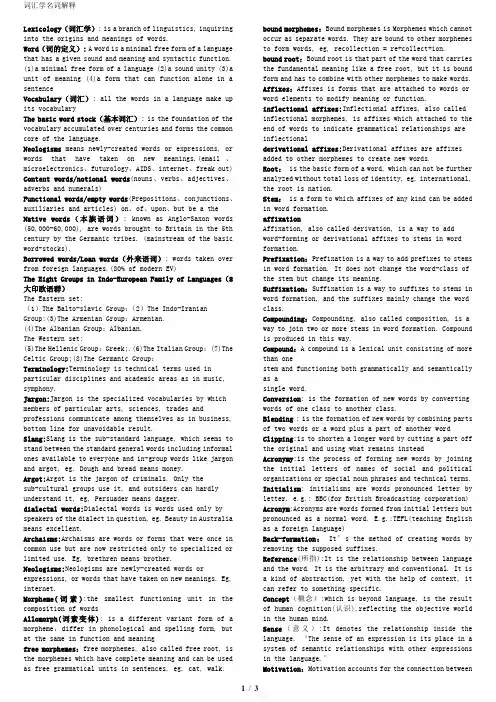
Lexicology(词汇学): is a branch of linguistics, inquiring into the origins and meanings of words.Word(词的定义): A word is a minimal free form of a language that has a given sound and meaning and syntactic function.(1)a minimal free form of a language (2)a sound unity (3)a unit of meaning (4)a form that can function alone in a sentenceVocabulary(词汇): all the words in a language make up its vocabularyThe basic word stock(基本词汇): is the foundation of the vocabulary accumulated over centuries and forms the common core of the language.Neologisms means newly-created words or expressions, or words that have taken on new meanings.(email、microelectronics、futurology、AIDS、internet、freak out) Content words/notional words(nouns、verbs、adjectives、adverbs and numerals)Functional words/empty words(Prepositions、conjunctions、auxiliaries and articles) on、of、upon、but be a the Native words(本族语词): known as Anglo-Saxon words (50,000-60,000), are words brought to Britain in the 5th century by the Germanic tribes. (mainstream of the basic word-stocks).Borrowed words/Loan words(外来语词): words taken over from foreign languages.(80% of modern EV)The Eight Groups in Indo-European Family of Languages(8大印欧语群)The Eastern set:(1)The Balto-slavic Group:(2)The Indo-Iranian Group:(3)The Armenian Group:Armenian.(4)The Albanian Group:Albanian.The Western set:(5)The Hellenic Group:Greek;.(6)The Italian Group:(7)The Celtic Group;(8)The Germanic Group:Terminology:Terminology is technical terms used in particular disciplines and academic areas as in music, symphony.Jargon:Jargon is the specialized vocabularies by which members of particular arts, sciences, trades and professions communicate among themselves as in business, bottom line for unavoidable result.Slang:Slang is the sub-standard language, which seems to stand between the standard general words including informal ones available to everyone and in-group words like jargon and argot, eg. Dough and bread means money.Argot:Argot is the jargon of criminals. Only thesub-cultural groups use it, and outsiders can hardly understand it, eg, Persuader means dagger.dialectal words:Dialectal words is words used only by speakers of the dialect in question, eg. Beauty in Australia means excellent.Archaisms:Archaisms are words or forms that were once in common use but are now restricted only to specialized or limited use. Eg, brethren means brother.Neologisms:Neologisms are newly-created words or expressions, or words that have taken on new meanings. Eg, internet.Morpheme(词素):the smallest functioning unit in the composition of wordsAllomorph(词素变体): is a different variant form of a morpheme,differ in phonological and spelling form, but at the same in function and meaningfree morphemes:free morphemes, also called free root, is the morphemes which have complete meaning and can be used as free grammatical units in sentences, eg. cat, walk.bound morphemes:Bound morphemes is Morphemes which cannot occur as separate words. They are bound to other morphemes to form words, eg, recollection = re+collect+ion.bound root:Bound root is that part of the word that carries the fundamental meaning like a free root, but it is bound form and has to combine with other morphemes to make words.Affixes:Affixes is forms that are attached to words orword elements to modify meaning or function.inflectional affixes:Inflectional affixes, also calledinflectional morphemes, is affixes which attached to the end of words to indicate grammatical relationships areinflectionalderivational affixes:Derivational affixes are affixesadded to other morphemes to create new words.Root: is the basic form of a word, which can not be further analyzed without total loss of identity, eg, international, the root is nation.Stem: is a form to which affixes of any kind can be added in word formation.affixationAffixation, also called derivation, is a way to addword-forming or derivational affixes to stems in wordformation.Prefixation:Prefixation is a way to add prefixes to stems in word formation. It does not change the word-class ofthe stem but change its meaning.Suffixation:Suffixation is a way to suffixes to stems in word formation, and the suffixes mainly change the wordclass.Compounding:Compounding, also called composition, is away to join two or more stems in word formation. Compound is produced in this way.Compound:A compound is a lexical unit consisting of more than onestem and functioning both grammatically and semantically as asingle word.Conversion: is the formation of new words by convertingwords of one class to another class.Blending : is the formation of new words by combining parts of two words or a word plus a part of another wordClipping:is to shorten a longer word by cutting a part off the original and using what remains insteadAcronymy:is the process of forming new words by joining the initial letters of names of social and political organizations or special noun phrases and technical terms.Initialism: initialisms are words pronounced letter by letter. e.g.: BBC(for British Broadcasting corporation)Acronym:Acronyms are words formed from initial letters but pronounced as a normal word. E.g.:TEFL(teaching English as a foreign language)Back-formation: It’s the method of creating words by removing the supposed suffixes.Reference(所指):It is the relationship between language and the word. It is the arbitrary and conventional. It isa kind of abstraction, yet with the help of context, itcan refer to something specific.Concept(概念):which is beyond language, is the result of human cognition(认识),reflecting the objective world in the human mind.Sense(意义):It denotes the relationship inside the language. ‘The sense of an expression is its place in a system of semantic relationships with other expressions in the language.’Motivation:Motivation accounts for the connection between1/ 3the linguistic symbol / word-form and its meaning. onomatopoeic motivation:Onomatopoeic Motivation is the character of some words whose sounds suggest their meanings, eg, crow by cocks.Morphological motivation (形态理据):multi-morphemic words and the meaning of many are the sum total of the morphemes combines. E.g.: airmail, miniskirt .例外:black market, ect.semantic motivation:Semantic motivation is the mental associations suggested by the conceptual meaning of a word. Eg, the mouth of the river.etymological motivation:The meanings of many words relate directly to their origins.Grammatical meanings is the part of the word’s meaning which indicates grammatical relationships such as speech of words, singular and plural meaning of nouns and their inflectional forms and so on.Conceptual meaning(概念意义): also known as denotative meaning(外延意义) is the meaning given in the dictionary and forms the core of word-meaning.Associative meaning(关联意义):is the secondary meaning supplemented to the conceptual meaningaffective meaning:Affective meaning indicates the speaker’s attitude towards theperson or thing in question, eg, notorious, meaning famous, shows the attitude of disapproval.collocative meaning:Collocative meaning is that part of the word-meaning suggested by the words before or after the word in discussion.Homonymy(同形同音异义关系):words different in meaning but either identical both in sound and spelling or identical only in sound or spelling.Perfect homonyms(完全同音同形异义词):words identical both in sound and spelling, but different in meaning. Homographs(同形异义词):words identical only in spelling, but different in sound and meaning.(最多最常见) Homophones(同音异义词):words identical only in sound but different in spelling and meaning.Polysemy is a fact that a word has more than one meaning Synonymy(同义关系): one of two or more words in the English language which have the same or very nearly the same essential meaning .Absolute synonyms(完全同义词):also known as complete synonyms are words which are identical in meaning in all aspects, i.e. both in grammatical meaning and lexical meaning, including conceptual and associative meanings.[ Absolute synonyms are restricted to highly specialized vocabulary in lexicology. ]relative synonyms(相对同义词):also called near-synonyms are similar or nearly the same in denotation, but embrace different shades of meaning or different degrees of a given quality.Antonymy (反义关系) :it is concerned with semantic opposition. Antonyms can be defined as words which are opposite in meaning.contradictory terms:Contradictory terms are antonyms truly representing oppositeness of meaning, so they are mutually exclusive and admit no possibility between them. Eg, male vs female.contrary terms:Contrary terms are antonyms in terms of a scalerunning between two poles or extremes. Eg, rich vs poor. relative terms:Relative terms are words indicating such a reciprocal social relationship that one of them cannot be used without suggesting the other. Eg, parent vs child.Hyponymy(上下义关系): Hyponymy deals with the relationship of semantic inclusion. The meaning of a more specific word is included in that of another more general word. For example, a cat is hyponym of animalSuperordinate and Subordinate(上义词和下义词):use subordinates which are concrete and precise ,presentinga vivid verbal picture before the reader. Superordinateswhich convey only a general and vague idea.Semantic Field(语义场)Viewing the total meaning in this way is the basis of field theory.The semantic field of the same concept may not have the same members in different language.1.Extension /generalization(词义的扩大): is the name givento the widening of meaning which some words undergo. It is a process by which originally had a specialized meaning has now become generalized.(e.g: manuscript, fabulous, picture, mill, journal, bonfire, butcher, companion)2.Narrowing/ specialization(词义的缩小):is the oppositeof widening meaning. It is a process by which a word of wide meaning acquires a narrower or specialized sense. In other words, a word which used to have a more general sense becomes restricted in its application and conveys a special meaning in present-day English.(e.g: deer, corn, garage, liquor, meat, disease, poison, wife, accident, girl).[ when a common word is turned into a proper noun, the meaning is narrowed accordingly. ]3.Elevation /amelioration(词义的升华):refers to theprocess by which words rise from humble(粗陋的) beginnings to positions of importance. [nice, marshal, constable, angel, knight, earl, governor, fond, minister, chamberlain ]4.Degradation / pejoration(词义的降格):A process wherebywords of good origin fall into ill reputation or non-affective words come to used in derogatory(贬损的)sense.[boor, churl, wench, hussy, villain, silly, knave, lewd, criticize, lust ]5.Transfer(词义的转移): Words which were used to designate指明 one thing but later changed to mean something else have experienced the process of semantic transfer.Context in its traditional sense refers to the lexical items that precede or follow a given word. Modern linguists have broadened its scope to include both linguistic and extra-linguistic contexts.1. Extra-linguistic context/ Non-linguistic situation(非语言语境):In a broad sense, context includes the physical situation as well, which embraces the people, time, place, and even the whole cultural background. (look out, weekend, landlord )2.Linguistic context/ grammatical context(语言语境):Ina narrow sense, it refers to the words, clauses, sentencesin which a word appears. It may cover a paragraph, a whole chapter and even the entire book.分为两类:Lexical context(词汇语境):It refers to the word that occurs together with the word in question. (e.g: paper, do)Grammatical context(语法语境):It refers the situation when the meaning of a word may be influenced by the structure in which it occurs. (e.g: become)Idioms(习语的定义): are expressions that are not readily understandable from their literal meaning of individual elements. In a broad sense, idiom may include colloquialisms(俗语), Catchphrases(标语),slang expressions (俚语),proverbs(谚语),etc. They form an important part of the English vocabulary..Semantic unity (语意的整体性): words in the idiom they2/ 3have lost their individual identity. Their meanings arenot often recognizable in the meaning of the whole idiom.The semantic unity of idioms is also reflected in the illogical relationship between the literal meaning of eachof the idiom.2.Structural stability(结构的稳定性):the structure of anidiom is to a large extent un changeable.1) the constituents of idioms cannot be replaced2) the word order cannot be inverted or changed3) the constituents of idioms cannot be deleted or addedto, not even an article.4) many idioms are grammatically unchangeableidioms nominal in nature :Idioms nominal in nature havea noun as the key word in each and function as a noun in sentences.idioms adjectival in nature:Idioms adjectival in nature function as a adjective but are not necessarily composedof adjectives.Idioms verbal in nature can be divided into phrasal verbsand other verb phrases.Idioms adverbial in nature contains many prepositional phrases and function as adverbial.Eg, tooth and nail, in nothing flat, through thick and thin,in clover, in the clover.Dictionary: presents in alphabetical order the words of English, with information as to their spelling ,pronunciation, meaning, usage , rules and grammar,and in some, their etymology3/ 3。
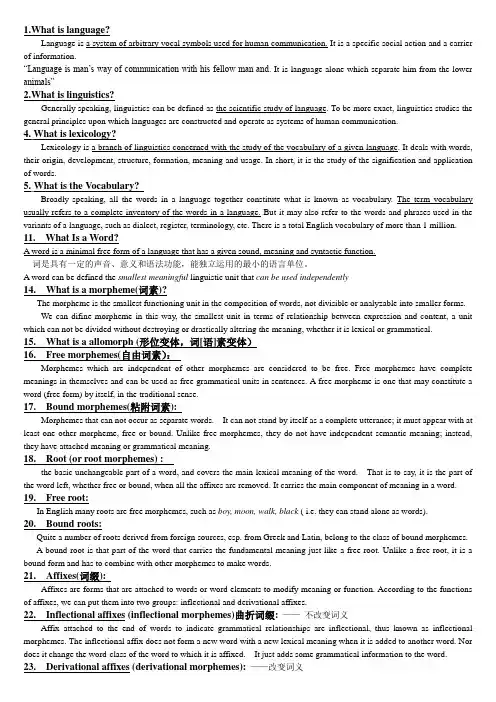
1.What is language?Language is a system of arbitrary vocal symbols used for human communication. It is a specific social action and a carrier of information.“Language is man’s way of communication with his fellow man and. It is language alone which separate him from the lower animals”2.What is linguistics?Generally speaking, linguistics can be defined as the scientific study of language. To be more exact, linguistics studies the general principles upon which languages are constructed and operate as systems of human communication.4.What is lexicology?Lexicology is a branch of linguistics concerned with the study of the vocabulary of a given language. It deals with words, their origin, development, structure, formation, meaning and usage. In short, it is the study of the signification and application of words.5.What is the Vocabulary?Broadly speaking, all the words in a language together constitute what is known as vocabulary. The term vocabulary usually refers to a complete inventory of the words in a language. But it may also refer to the words and phrases used in the variants of a language, such as dialect, register, terminology, etc. There is a total English vocabulary of more than 1 million.11. What Is a Word?A word is a minimal free form of a language that has a given sound, meaning and syntactic function.词是具有一定的声音、意义和语法功能,能独立运用的最小的语言单位。
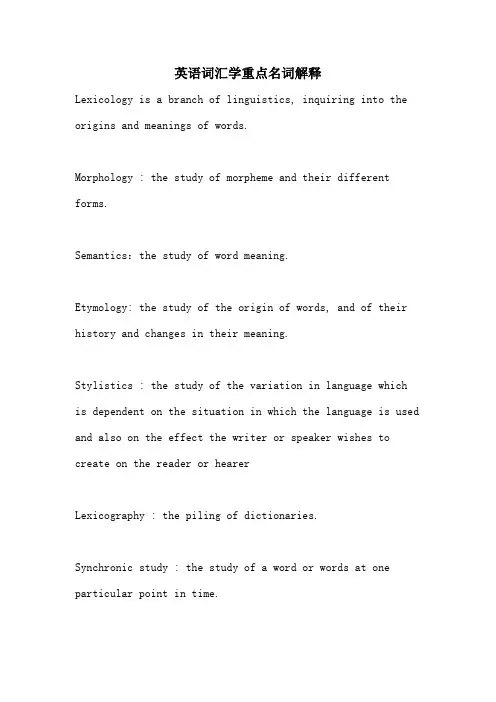
英语词汇学重点名词解释Lexicology is a branch of linguistics, inquiring into the origins and meanings of words.Morphology : the study of morpheme and their different forms.Semantics:the study of word meaning.Etymology: the study of the origin of words, and of their history and changes in their meaning.Stylistics : the study of the variation in language which is dependent on the situation in which the language is used and also on the effect the writer or speaker wishes to create on the reader or hearerLexicography : the piling of dictionaries.Synchronic study : the study of a word or words at one particular point in time.Diachronic study: an approach to lexicology which studies how a word (or words) changes over a period of time. word: a word is a minimal free form of a language that has a given sound and meaning and syntactic function.vocabulary:Vocabulary refers to the total number of the words in a language, but it can stand for all the words used in a particular historical period.Vocabulary also refers to all the words of a given dialect, given book, a given disciplineand the words possessed by an individual person.Terminology术语 consists of technical terms used in particular disciplines and academic areas as in medicine: Jargon 行话refers to the specialized vocabularies by which members of particular arts, sciences, trades and professions municate among themselves such as in business.slang 俚语belongs to the sub-standard language, a category that seems to stand between the standard general wordsincluding informal ones available to everyone and in-group wordsArgot黑话 generally refers to the jargon of criminals. Its use is confined to the sub-cultural groups, and outsiders can hardly understand it,Archaisms古词语 are words or forms that were once in mon use but are now restricted only to specialized or limited use.《英语词汇学重点名词解释》全文内容当前网页未完全显示,剩余内容下一页查看。
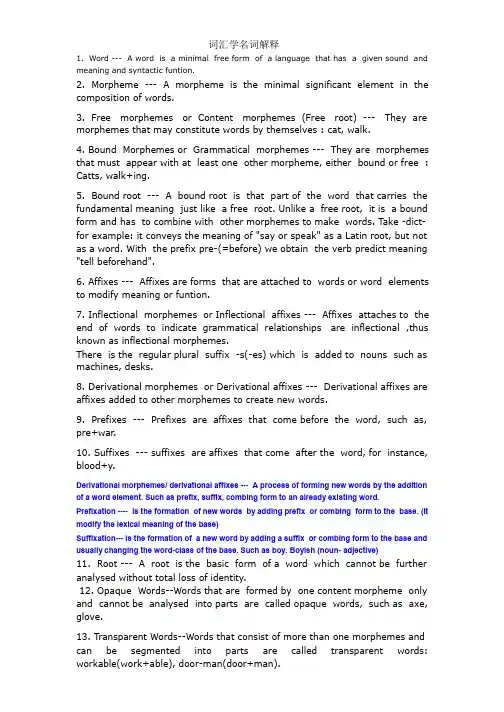
词汇学名词解释1. Word --- A word is a minimal free form of a language that has a given sound and meaning and syntactic funtion.2. Morpheme --- A morpheme is the minimal significant element in the composition of words.3. Free morphemes or Content morphemes (Free root) --- They are morphemes that may constitute words by themselves : cat, walk.4. Bound Morphemes or Grammatical morphemes --- They are morphemes that must appear with at least one other morpheme, either bound or free : Catts, walk+ing.5. Bound root --- A bound root is that part of the word that carries the fundamental meaning just like a free root. Unlike a free root, it is a bound form and has to combine with other morphemes to make words. T ake -dict- for example: it conveys the meaning of "say or speak" as a Latin root, but not as a word. With the prefix pre-(=before) we obtain the verb predict meaning "tell beforehand".6. Affixes --- Affixes are forms that are attached to words or word elements to modify meaning or funtion.7. Inflectional morphemes or Inflectional affixes --- Affixes attaches to the end of words to indicate grammatical relationships are inflectional ,thus known as inflectional morphemes.There is the regular plural suffix -s(-es) which is added to nouns such as machines, desks.8. Derivational morphemes or Derivational affixes --- Derivational affixes are affixes added to other morphemes to create new words.9. Prefixes --- Prefixes are affixes that come before the word, such as, pre+war.10. Suffixes --- suffixes are affixes that come after the word, for instance, blood+y.Derivational morphemes/ derivational affixes --- A process of forming new words by the addition of a word element. Such as prefix, suffix, combing form to an already existing word.Prefixation ---- is the formation of new words by adding prefix or combing form to the base. (It modify the lexical meaning of the base)Suffixation--- is the formation of a new word by adding a suffix or combing form to the base and usually changing the word-class of the base. Such as boy. Boyish (noun- adjective)11. Root --- A root is the basic form of a word which cannot be further analysed without total loss of identity.12. Opaque Words--Words that are formed by one content morpheme only and cannot be analysed into parts are called opaque words, such as axe, glove.13. Transparent Words--Words that consist of more than one morphemes and can be segmented into parts are called transparent words: workable(work+able), door-man(door+man).14. Morphs--Morphemes are abstract units, which are realized in speech by discrete units known as morphs. They are actual spoken, minimal carriers of meaning.15. Allomorps--Some morphemes are realized by more than one morph according to their position in a word. Such alternative morphs are known as allomorphs. For instance, the morpheme of plurality {-s} has a number of allomorphs in different sound context, e.g. in cats /s/, in bags /z/, in match /iz/.16. Derivation or Affixation--Affixation is generally defined as the formation of words by adding word-forming or derivational affixes to stems. This process is also known as derivation.17. Prefixation--Prefixation is the formation of new words by adding prefixes to stems.18. Suffixation--Suffixation is the formation of new words by adding suffixes to stems.19. Compounding(Compositon)--Compounding is a process of word- formation by which two independent words are put together to make one word. E.g. hen-packed; short-sighted.20. Conversion--Conversion is the formation of new words by converting words of one class to another class. This process of creating new words without adding any affixes is also called zero-derivation. E.g. dry (a.)-->to dry.21. Back-formation-- is a process of word-formation by which a word is created by the deletion of a supposed affix. E.g. editor entered the language before edit.22. Abbreviation ( shortening )-- is a process of word-formation by which the syllables of words are abbreviated or shortened.23. Abbreviation includes four types : I. Clipped words II. Initialisms III. Acronyms IV. Blends.I. Clipped words--are those created by clipping part of a word, leaving only a piece of the old word. E.g. telephone-->phone, professional-->pro.II. Initialisms--are words formed from the initial letters of words and pronounced as letters. E.g. IMF/ai em ef/=International Monetary Fund.III. Acronyms--are words formed from the initial letters of word and pronounced as words. E.g. NATO/'neito/=North Atlantic Treaty Organization.IV. Blends--are words that are combined by parts of other words. E.g. smoke+fog=smog.24. Polysemy--The same word may have two or more different meanings. This is known as "polysemy". The word "flight", for example, may mean "passing through the air", "power of flying", "air of journey", etc.Two approaches to polysemy: Diachronic and SynchronicDiachronically, we study the growth or change in the semantic structure of a word , or how the semantic structure of a word has developed from primary meaning to the present polysemic state .Synchronically, we are interested in the comparative value of individual meanings and the interrelation between the central meaning and the secondary meanings.Two processes leading to polysemy: Radiation and concatenationRadiation : Semantically, radiation is the process in which the primary or central meaning stands at the center while secondary meanings radiate from it in every direction like rays. Concatenation : is a semantic process in which the meaning of a word moves gradually away from its first sense by successive shifts, like the links of a chain, untill there is no connection between the sense that is finally developed and the primary meaning.25. Homonyms--are generally defined as words different in meaning but either identical both in sound and spelling or identical『a.同一的,完全相同的』only in sound or spelling.26. Perfect Homonyms--are words identical both in sound and spelling,but different in meaning。
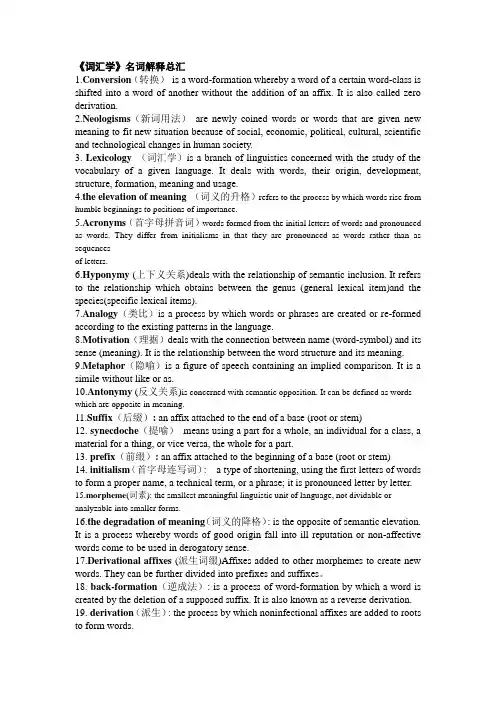
《词汇学》名词解释总汇1.Conversion(转换)is a word-formation whereby a word of a certain word-class is shifted into a word of another without the addition of an affix. It is also called zero derivation.2.Neologisms(新词用法)are newly coined words or words that are given new meaning to fit new situation because of social, economic, political, cultural, scientific and technological changes in human society.3. Lexicology(词汇学)is a branch of linguistics concerned with the study of the vocabulary of a given language. It deals with words, their origin, development, structure, formation, meaning and usage.4.the elevation of meaning(词义的升格)refers to the process by which words rise from humble beginnings to positions of importance.5.Acronyms(首字母拼音词)words formed from the initial letters of words and pronounced as words. They differ from initialisms in that they are pronounced as words rather than as sequencesof letters.6.Hyponymy (上下义关系)deals with the relationship of semantic inclusion. It refers to the relationship which obtains between the genus (general lexical item)and the species(specific lexical items).7.Analogy(类比)is a process by which words or phrases are created or re-formed according to the existing patterns in the language.8.Motivation(理据)deals with the connection between name (word-symbol) and its sense (meaning). It is the relationship between the word structure and its meaning. 9.Metaphor(隐喻)is a figure of speech containing an implied comparison. It is a simile without like or as.10.Antonymy (反义关系)is concerned with semantic opposition. It can be defined as words which are opposite in meaning.11.Suffix(后缀): an affix attached to the end of a base (root or stem)12. synecdoche(提喻)means using a part for a whole, an individual for a class, a material for a thing, or vice versa, the whole for a part.13. prefix(前缀): an affix attached to the beginning of a base (root or stem)14. initialism(首字母连写词): a type of shortening, using the first letters of words to form a proper name, a technical term, or a phrase; it is pronounced letter by letter. 15.morpheme(词素): the smallest meaningful linguistic unit of language, not dividable or analyzable into smaller forms.16.the degradation of meaning(词义的降格): is the opposite of semantic elevation. It is a process whereby words of good origin fall into ill reputation or non-affective words come to be used in derogatory sense.17.Derivational affixes (派生词缀)Affixes added to other morphemes to create new words. They can be further divided into prefixes and suffixes。
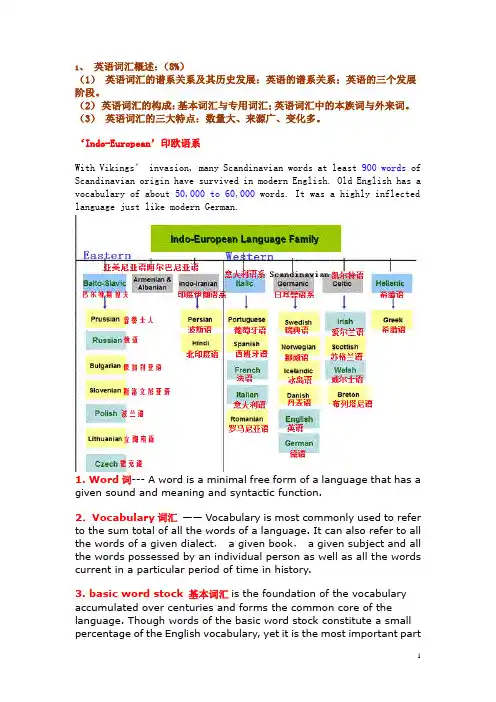
1、英语词汇概述:(8%)(1)英语词汇的谱系关系及其历史发展:英语的谱系关系;英语的三个发展阶段。
(2)英语词汇的构成:基本词汇与专用词汇;英语词汇中的本族词与外来词。
(3)英语词汇的三大特点:数量大、来源广、变化多。
‘Indo-European’印欧语系With Vikings’ invasion, many Scandinavian words at least 900 words of Scandinavian origin have survived in modern English. Old English has a vocabulary of about 50,000 to 60,000 words. It was a highly inflected language just like modern German.1. Word词--- A word is a minimal free form of a language that has a given sound and meaning and syntactic function.2.Vocabulary词汇—— Vocabulary is most commonly used to refer to the sum total of all the words of a language. It can also refer to all the words of a given dialect,a given book,a given subject and all the words possessed by an individual person as well as all the words current in a particular period of time in history.3. basic word stock 基本词汇is the foundation of the vocabulary accumulated over centuries and forms the common core of the language. Though words of the basic word stock constitute a small percentage of the English vocabulary, yet it is the most important partof it. These words have obvious characteristics.(1)All national character全民性. Words of the basic word stock denote the most common things and phenomena of the world around us, which are indispensable to all the people who speak the language。
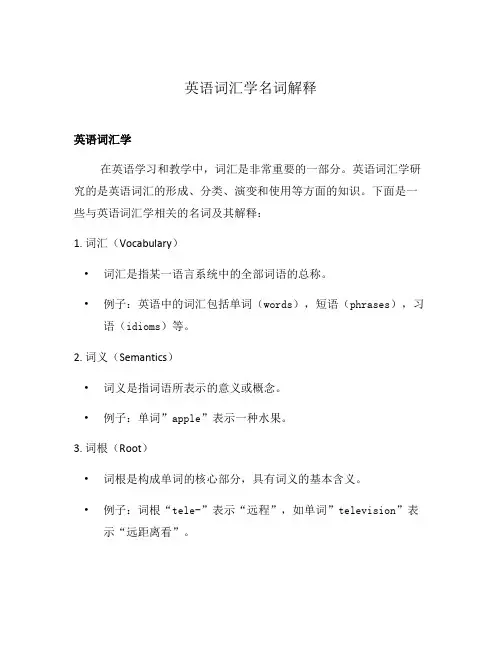
英语词汇学名词解释英语词汇学在英语学习和教学中,词汇是非常重要的一部分。
英语词汇学研究的是英语词汇的形成、分类、演变和使用等方面的知识。
下面是一些与英语词汇学相关的名词及其解释:1. 词汇(Vocabulary)•词汇是指某一语言系统中的全部词语的总称。
•例子:英语中的词汇包括单词(words),短语(phrases),习语(idioms)等。
2. 词义(Semantics)•词义是指词语所表示的意义或概念。
•例子:单词”apple”表示一种水果。
3. 词根(Root)•词根是构成单词的核心部分,具有词义的基本含义。
•例子:词根“tele-”表示“远程”,如单词”television”表示“远距离看”。
4. 词形(Morphology)•词形是指词语形态上的变化,包括词根的变化、词缀的添加和词语形式的变化等。
•例子:单词”run”经过词形变化可以有”running”(进行时态)和”ran”(过去时态)等形式。
5. 词汇量(Vocabulary Size)•词汇量是指一个人掌握或理解的词汇数量。
•例子:一般来说,英语水平高的人词汇量会相对较大。
6. 同义词(Synonym)•同义词是指语义相近的两个或多个词语。
•例子:“happy”和”glad”都是表示“高兴”的同义词。
7. 反义词(Antonym)•反义词是指意义相对立的两个词语。
•例子:“big”和”small”是表示“大”和“小”的反义词。
8. 多词性(Polysemy)•多词性是指一个词语具有多个不同但相关的词义。
•例子:单词”bank”可以表示“银行”或“河岸”。
9. 词汇补偿(Vocabulary Compensation)•词汇补偿是指在理解语言时,通过上下文和其他线索来推测未知词汇的意义。
•例子:如果不认识单词”obscure”,可以通过上下文来猜测它的意义是“不清楚的”。
这些名词和概念在英语词汇学中起着重要的作用,了解它们可以帮助我们更好地学习和使用英语词汇。

词汇学名词解释词汇学是研究语言中的词汇(单词)和词汇使用的学科。
在词汇学中,有很多专业术语,下面将对其中的几个常用术语进行解释。
1. 词汇(Vocabulary):语言中使用的词语的集合。
2. 词(Word):语言中的最小语言单位,具有单独的意义和语音形式。
3. 词根(Root):词中含有全词意义的核心成分,通常是一个字母组合。
例如,“tele-”是“telephone”这个词的词根。
4. 词缀(Affix):可以加在词根前、中或后的一个或多个字母,用于改变词的含义。
例如,“-er”是“teacher”这个词的词缀。
5. 合成词(Compound Word):将两个或更多的词或词根组合成一个新的词。
例如,“lighthouse”(灯塔)由“light”和“house”两个词合成而成。
6. 前缀(Prefix):位于词根前面的一个或多个字母,可以改变词的含义。
例如,“re-”是“return”这个词的前缀。
7. 后缀(Suffix):位于词根后面的一个或多个字母,可以改变词的词性或含义。
例如,“-able”是“comfortable”这个词的后缀。
8. 短语(Phrase):由两个或多个单词组成的词组,没有主语和谓语。
例如,“in the morning”(在早晨)是一个短语。
9. 句子(Sentence):有明确的主语和谓语,可以表达一个完整的意思。
以上是词汇学中常见的术语解释,它们有助于我们更好地理解语言中的单词和词组。
除此之外,词汇学还研究了词的来源、演变、分类和使用等方面,是一门十分重要的学科。
英语词汇学重点名词解释Word a word is a minimal free form of a language that has a giving sound and meaning and syntactic function.Native w ords are words brought to Britain in the fifth century by the German tribes. They are neutral in style and frequent in use.Denizens are words borrowed early in the past and now are well assimilated into English language. In other words they have come to comfort to the English way of pronunciation and spelling.Translation-loans are words and expressions formed from the existing material in the English language but modelled on the patterns taken from another language.Aliens are borrowed words which have retained their original pronunciation and spelling.Semantic-loans refers to words whose meanings are borrowed and whose forms are not borrowed. Creation refers to the formation of new words by using the existing material, namely roots, affixes and other elements.Semantic change means an old form which takes on a new meaning to meetthe new need.Mopheme the smallest functioning unit in the composition of words.Free mophemes are independent of other mophemes and have complete meanings in themselves and can be used as free grammarical units in sentences. They are identical with root words.Bound mophemes A mopheme that occurs with at least one other mopheme.Stem is a form to which affixes of any kind can be added.Affixes are forms that are attached to words or word elements to modify meaning or function.Inflectional affix is an affix that indicates grammatical relationships.Derivational affix is an affix that forms new words with a stem or a root.Affixation It is also called derivation, is the formation of new words by adding affix to stems.Prefixation is the formation of new words by adding prefixes to stems. Prefixes do not generally change the word-class of the stem but only modify its meaning.Conversion the formation of new words by converting words of one class to another class.Blending the formation of new words by combining parts of two words or a word plus a part of another word. Clipping to shorten a longer word by cutting a part off the original and using what remains instead. Acronyms are words formed from initial letters but pronounced as a normal word.Back-formation is the method of creating words by removing the supposed suffixes.Initialisms are words pronunced letter by letter.Semantic motivation refers to the mental associations suggested by the conceptual meaning of a word. It explains the connection between the lieral sense and figurative sense of the word..Morphological motivation accounts for the connection between the meaning of the word and the me aning of each morpheme in the word.Onomatopoeic motivation indicates the relationship between sound and meaning of a word . I ts sound suggests its meaning.Grammarical meaning refers to that part of the meaning of the word which indicates grammarical concept or relationships.Conceptual meaning the meaning giveb in the dictionary forms the core of word meaning.Connotation (Connotative meaning ) refers to the overtones or associations suggested by the conceptual meaning.Affective meaning indicates the speaker’s attitude towards the person or thing in question.Collocative meaning the word meaning which is suggested by t he words before or after the word in discussion.Reference is the relationship between language and the world.Concept Concept, which is beyond language, is the result of human cognition, reflecting the objective world in the human mind.Radiation a semantic process in which the primary meaning stands at the centre secondary meaning proceed out of it in every direction like rays.Concatenation a process where each of the later meaning is related only to the preceding one like chains.Polysemy words that have two or more than two sense.Homonymy words different in meaning but either identical both in sound and spelling or identical only in sound or meaning.Perfect homonyms are words identical both in sound and in spelling, but different in meaning.Synonym one of two or more words in the English language which have the same or very nearly the same essential meaning.Antonyms can be defined as words which are opposite in meaning.Hyponymy deals with the relationship of semantic inclusion. That is, the meaning of a more specific word is included in that of another more general word.Primary meaning is the only first meaning that a word had when it was created.Extension (Generalization) A process by which a word which originally had a specialized me aning has now become generalized.Narrowing (Specialication) It is also called specialication. It is the opposite of widening meaning. It is a process by which a word of wide meaning acquires a narrower or specialized sense.Degradation is a process whereby words of good origin fall into ill reputation or non-affective words come to be used in derogatory sense..Amelioration ( Elevation ) is also called elevation, a term referring to the process by which words rise from humble beginning to positions of importance..Transfer words which were used to designate one thing but later changed to mean something else have experienced the process of semantic transfer.Linguistic context refers to the words, clauses, sentenses in which a word appears.Extra-linguistic context is also called non-linguistic context, which includes people, time, place, even the whole cultural background..Lexical context refers to the word occur together with the word in question.Grammatical context In some cases, the meaning of a word may be influenced by the structure in which it occurs.Metonymy the name of one thing is used for that of another associated with it.Synecdoche is that of substituting part for the whole and vice versa.Idioms strictly speaking, idioms are expr essions that are not readily understandable from their literal meanings of individual elements.Idioms nominal in nature idioms of this class have a noun as the key word in each and function as a noun in sentences.Specialized dictionary is a dictionary concentrationg on a particular area of language or knowledge. Unabridged dictionary As the name indicates, an unabridged dictionary is an unshortened one. Theoretically, it is a complete record of all the words in use ( actually no dictionariy can contain all the words in the language ).Desk dictionaries are medium-sized ones containing words ranging from 50,000 to 150,000. As they are dictionaries that one finds most used on desks, th ey are called desk dictionaries.。
词汇学名词解释词汇学1、Compounding(合成法)Compounding is a word-formation process of joining two or more bases to form a new unit, a compound word.e.g. blackboard, air-conditioning, flowerpot2、Derivation(派?生法)= a?xation(词缀法)A word-formation process by which new words are created by adding a prefix, or su?x,or both, to the base.e.g. belittle, debug, anti-war3、Conversion(词性转移法)Conversion is a word-formation process whereby a word of a certain word-class is shifted into a word of another word-class without the addition of an a?x.e.g. attack (v. & n.), compound (v. & n.), permit (v. & n.)4、Initialisms(?首字?母连写词)Initialism is a type of shortening, using the first letters of words to form a proper name, a technical term, or a phrase; it is pronounced letter by letter.e.g. BBC (British Broadcasting Corporation), VIP (a very important people)5、Acronyms(?首字?母拼?音词)Acronyms are words formed from the initial letters of the name of an organization or a scientific term.e.g. OPEC, BASIC, SAM, TEFL, UNESCO6、Clipping(剪裁法)The process of clipping involves the deletion of one or more syllables from a word (usually a noun), which is also available inits full form.e.g. plane from airplane, phone from telephone, gym from gymnastics, taxi from taxicab7、Blending(混合法)Blending is a process of word-formation in which a new word is formed by combining the meanings and sounds of two words, one of which is not in its full form or both of whichare not in their full forms.e.g. newscast (news + broadcast), brunch (breakfast + lunch)8、Back formation(逆构法)Back-formation is a term used to refer to a type of word-formation by which a shorterword is coined by the deletion of a supposed a?x from a longer form already present in the language.e.g.the verb resurrect was formed from the noun resurrection by removing the supposed derivative su?x -ion, and the verb edit formed from editor by dropping the su?x -or.9、Words from proper names(专有名词构词法)The words that coined from the di?erent proper names. Such as the names of people, the names of places, the names of books, or the names of brands.e.g. watt, hertz, Nicotine10、Reduplication(复制法)Reduplication is a minor type of word-formation by which a compound word is created by the repetition (1)of one word like go-go; (2)of two almost identical words with a change in the vowel’s such as ping-pong; (3) of two almost identical words with a change in the initial consonants, as in teenyweeny.11、Coinage(新造的字)Coinage is a process of inventing words not based onexisting morphemes.e.g. fruice = fruit +juice, slanguage =slang + language12、Classification of English words according to di?erent criteriaA. By origin:1) native words2) loan wordsB. By level of usage :1)common words2)literary words3)colloquial words4)slang words5)technical wordsC. By notion:1)function words(虚词)2)content words (实词)13、inflectional morpheme (or inflectional a?xes) (曲折词缀)An inflectional aifix serves to express such meanings as plurality, tense, and the comparative or superlative degree. It does not form a new word with new lexical meaning when it is added to another word. Nor does it change the word-class of the word to which it is a?xed.e.g. “s” in chairs, pens ; “es” in boxes, tomatoes;“en” in oxen14、root(词根)(1) 书:A root is the basic unchangeable part of a word, and it conveys the main lexical meaning of the word.e.g. work, boy, moon, walk(2) ?网:A root is a form which is not further analysable, either in terms of derivational or inflectional morphology. A rootis the basic part always present in a lexeme.15、stem(词?干)Stem is the part of the word-form which remains when all inflectional a?xes have been removed.e.g. in the word undesirables, the stem is undesirable;in the word desired, the stem is desire16、base(词基)Base is any form to which a?xes of any kind can be added.e.g. in the word desirable, desire is the base to which a su?x -able is added.17、echoic words or onomatopoeic words(拟声词或象声词)Words motivated phonetically are called echoi words or onomatopoeic words, whose pronunciation suggests the meaning.e.g. the woof-woof of a dog, the miaow of a cat18、homonyms(异义词)In the English language, there are many pairs or groups of words, which, though di?erent in meaning, are pronounced alike, or spelled alike, or both.e.g. lead (n. & v.), sow (n. & v.), tear (n. & v.)19、complementary antonyms(互补性反义词)Complementaries or contradictories represent a type of binary semantic opposition. In a complementary pair the contrast between the two terms is absolute.e.g. alive and dead, single and married20、synchronic dictionary(共时词典)Synchronic dictionaries describe the vocabulary of a certain period or at a certain stage of the development of the language, providing the from, meaning, usage, etc., of the words of the period.e.g. COD, WCD21、allomorph(同位异形体)An allomorph is any of the variant forms of a morpheme as conditioned by position or adjoining sounds.e.g. the allomorphs -ion/-tion/-sion/-ation are the positional variants of the same su?x22、prefixation(前缀)Prefixation is the formation of new words by adding a prefix or combining form to the base.e.g. de-, be-, en-23、semantic motivation(语义动机)Semantic motivation refers to motivation based on semantic factors. It is a kind of mental association.e.g.When we speak of a stony heart we are comparing the heart with a stone; when we say the leg of a table, we are comparing the tables leg with one of the lower limbs of a human being.24、a?ective meaning(情感意义)A?ective meaning is concerned with the expression of feelings and attitudes of the speaker or writer.e.g. Aha! Alas! and Hurrah!25、hyponymy(上下义关系)Hyponymy is the relationship which obtains between specific and general lexical items, such that the former is “included” in the la tter.e.g. a cat is a hyponym of animal, flute of instrument, chair of furniture26、semantic field(语义场)(1)书:Semantic field theory "took the view that the vocabulary of a given language is not simply a listing ofindependent items (as the headwords in a dictionary would suggest), but is organized into areas, or fields, within which words interrelate and define each other in various ways."(2)?网:Semantic field theory is concerned with the vocabulary of a language as a system of interrelated lexical networks. The words of a semantic field are joined together by a common concept, and they are likely to have a number of collocations in common.e.g.The words red, green, white etc. make up the semantic field of colors;the words father, mother, son etc. make up the semantic field of kinship27、componential analysis(成分分析法)The analysis of word meanings is often seen as a process of breaking down the sense of a word into its minimal components.e.g. cow : [+ Bovine + Adult - Male]man : [+Human + Adult + Male]。
Abberbation 缩写;缩略Ablative case 夺格(即第五个或工具格)Absolute synonym 绝对同义词Accusative case 直接宾格Acronym 首字母缩略词Aderbial clause of concession 让步状语从句Affix 词缀Affixation 词缀法Alien 外国词Alliteration 头韵Alphabetical order 字母表顺序Amelioration 进化Analogy 类比Analytic language 分析性语言Anthropomorphic 拟人化的Antonym 反义词Antonymy 翻译关系Approach to 方法Archaism 古词Arbitrary 任意的Argot 黑话Autosemantic 词本身有独立意义的Base 词基Back-formation 逆成法Bilingual 双语的Blend 拼缀词Blending 拼缀法Borrowed word 借词Borrowing 借词Bound morpheme 粘着形位Briton 布立吞人Capitalization 大写Case 格Classical element 古典成分Clipping 缩短法Collocability 词的搭配能力Collocation 词的搭配Colloquialism 口语词Colloquial style 口语语体Combining form 构词成分Complementaries 互补性反义词Complex word 复合词Compound 合成词Compound word 合成词Compounding 合成法Concatenation 连锁型语义演变过程Conjugation 动词变位Connotative meaning 内含意义Context 语境Contraries 相对性反义词Conventional 约定俗成的Convergingsound-development 语音发展的一致性Conversion 转类法Conversives 换位性反义词Cosmopolitan character 国际性Dative case 与格(第三格)De-adjectival 由形容词转变而来的Declension 名词、形容词等的变格Degradation of meaning 意义的降格Denizen 外来词Denominal nouns :abstract 纯名词表示抽象意义Denominal nouns :concrete 纯名词表示具体意义Denotative meaning 外延意义Derivative antonym 派生反义词Deterioration 退化Deverbal noun 由动词派生的名词Diachronic approach 历时分析法Diachronic dictionary 历史语言学词典Diachrony 历时分析Dialect 方言Double genitive case 双生格Doublets 两词一组的同义词Elevation of meaning 意义的升格Encyclopaedic dictionary 百科全书词典Entry 词条Etymology 词源学Euphemism 委婉语Euphony 语音的和谐悦耳Existing word 现行的词Exocentric word 离心结构合成词Extension of meaning 意义的扩大Figure of speech 修饰手段Figurative use 比喻用法Foreign element 外来语成分Formal word 书面词Form-word 虚词Free from 自由形式Free morpheme 自由形位Free phrase 自由词组French element 法语成分Full conversion 完全转类法Full word 实词Functional word 虚词Generalization 一般化Genitive case 生格(第二格)General dictionary 一般性词典Glossary 难词Headword 词目Homoform 同语法形式异义词Homograph 同形异音异义词Homonym 同音异义词;同形异义词;同音同形异义词Homonymy 同音、同形、同音同形异义词的研究Homophone 同音异形异义词Hybrid 混合词Hyponym 下意词Hyponymy上下意关系Idiom 习语Idiomatic phrase 惯用语词组Imperative sentence 祈使句Indo-European family 印欧语系Inflected language 曲折性语言Informal word 口语词Jargon 行话Latin element 拉丁语成分Leveled inflections 曲折变化弱化Linguistic context 语言语境Literal use 字面用法Loan-word借词Locativecase 位置格Locative prefix 表示地点的前缀Lost inflections 曲折变化消失Main stress 主重音Medium-sized dictionary 中型词典Metaphor隐喻Middle English 中古英语Miscellaneous prefix 混合型前缀Monosemy 一词单意Morpheme 形位Morphology 词法Motivation 理据Multilingual 用多种语言表达的;多语的Narrowing of meaning 意义的缩小Native element 本族语成分Native word 本族语词Negative prefix 表示否定的前缀Neo-classical 新古典主义的Neologism 新词New word 新词Nominative case 主格Nonce word 临时造的词Non-linguistic context 非语言语境Notional word 实词Number prefix 表示数目的前缀Obsolete word 费词Official language 官方语言Old English 古英语Onomatopoeia 象声词Open 分开写的Orthographic criterion 正字法标准Part of the speech 词类Partial conversion 部分转类法Pejorative prefix 表示贬义的前缀Pahatic communion 交际性谈话Phonetics 语音学Phonology 音位学Phraseological idiom 熟语Physiology 生理学Pocket dictionary 小型词典Polarity 对立性Polysemic character 一词多义性Polysemy 一词多义Popular 通俗的Possessive case 所有格Preciseness 精确性Prefix 前缀Prefixation 前缀法Private prefix 表示反义的前缀radiation 放射型的语义演变过程reduplicative compound 或者reduplicative(s )重叠合成词reference 语词所指涵义referent 语词所指事物relative synonym 相对同义词repetition 重复representative work 代表作reversativeprefix表示反义的前缀rhyme 韵脚richness丰富性root 词根root antonym词根反义词Scandinavian element 斯堪的纳维亚语成分Secondary stress次重音Semantic borrowing(s)义借词Semantics语义学Semiotic triangle三角关系符号学理论Sense-shift语义转换Shade of meaning意义的(细微差别Shortening缩短法(the)sign theory of Saussure索绪尔符号理论Signified(借助符号进行交际的)事物的概念或涵义Signifier代表事物的概念或涵义符号Simile明喻Slang俚语solid(合成词中两个词)连起来写的special dictionary专门性词典specialization 特殊化Spelling拼写Stem词干Stylistics文体学Suffix后缀Suffixation后缀法(the)superordinate (term)上义词Survival(s)(vestiges)保留下来的词Sychronic approach共时分析法Sychronic dictionary共时语言学词典Synchrony共时分析。
Types of meaningTypes of lexical changes1.Elevation:词义升格Definition: words rise from humble beginnings to positions of importanceSome words early in their history signify something quite low or humble, but change as time goes by to designate something agreeable or pleasant.For example: nice: ignorant---foolish---delightful, pleasantMarshal: a keeper of horses---a high ranking army officerSo elevation refers that the meaning of word changes from the neutral/negative to positive.2.Old English:It refers to the English starting from 450 to 1100 AD. The oldEnglish is made up of different sources of languages spoken then –that of Anglo-Saxons, that of Celts, and that of Jutes, with a lot of Latin elements used for common peopl e’s life.3.Bound morpheme:It is the smallest unit of grammar, a unit which cannot occur as separate words. They have no independent semantic meaning; instead, they have:➢Attached meaning E.g. un-kind, hope-ful➢Grammatical meaning E.g. cat-s, slow-ly, walk-ing, call-edFor an exact example, in the word “careful”, care is free morpheme, “-ful” is a bound morpheme.4.Hyponymy:Hyponymy deals with the relationship of semantic inclusion, or to say, the relationship between general lexical items and specific lexical items. That is to say, when X is a kind of Y, the lower term X is the“hyponym”, and the upper term Y is the “superordinate”. For example, “fiction”is the superordinate of “novel”, “novelette”and “short story”, which are the hyponyms of “fiction”.Knowing the semantic features of the hyponyms and their superordinates can help us achieve vividness, exactness, and concreteness in expression.5.Collocation:Collocation is the habitual juxtaposition of linearly arranged words which occurs multiple times to become set expressions.Collocations have four features:➢They are non-arbitrary and predictable. For example, we can say “have tea” but not “have engine oil”➢They are stable and rigid. Collocations are strong enough to exclude other synonymous words. For example, we can say “strong wind and heavy rain” but not “strong rain and heavy wind”.➢They are culturally-loaded. Collocation reflects the English culture and cultural heritage, such as “the Trojan horse” and “Pandora’s box”.➢They are Language-specific.Collocations can be classified into: (in terms of collocational strength.)weak collocations, (collocations that have a wide variety of collocates. Collocational range is wide.E.g. white/red/green/long/small shirt)strong collocations,(Collocations are strong but not unique.E.g. moved to tears) frozen collocations (Collocations that are fixed and irreplaceable, E.g. foot the bill *foot the coffee)Collocations are non-arbitrary, which means that they are motivated. There are four kinds of motivations:Grammatical motivation, (Collocations serve particular grammatical functions in certain grammatical structures.)Semantic motivation, (The meaning of the collocation depends on the collocated components.)Pragmatic motivation, (Collocations are pragmatically driven and pragmatically shaped. E.g.Buckle up, keep space, )Cognitive motivation. (Metaphorical expression beyond literal interpretation.E.g. red-carpet treatment, political honeymoon, bubble economy, soft landing)Collocation is one important aspect of vocabulary development.It offers the most natural way of language use.It provides alternative ways of language use, which may be more colorful, expressive or precise.It helps to improve the style in writing.6.Morpheme:A morpheme is the smallest meaningful unit of a language. Morpheme can be lexical or grammatical.A free morpheme has complete meaning and can be used as free grammatical units in sentences.A bound morpheme cannot occur as separate words. They are bound to other morphemes to form words.An inflectional morpheme is a morpheme that is used to inflect a word. e.g. white can be inflected with the morphemes -r (whiter) and -est (whitest)A derivational morpheme is a morpheme that is used to create derivations of words. e.g. white can form the derivation whiten by adding the -n morpheme.7.Stylistic meaning:Apart from their conceptual meanings, many words have stylistic features, which make them appropriate for different contexts. These distinctive features form stylistic meaning of words. In some dictionaries ,these stylistic features are clearly marked as “formal”, “informal”, “ literary”, “archaic”, “slang” and so on. This stylistic difference is especially true of synonyms. It is observed that there are few words which have both the same conceptual meaning and the stylistic meaning.8.Analogy:Analogy refers to the process by which words or phrases are created or re-formed according to the existing patterns in the language.E.g. youthquake, airbag, earthriseearthquake, handbag, sunrisepounding:It is a type of word-formation process consisting of joining two or more bases to form a new unit, a compound word. It is also a productive device at every period of the English language. Forms of compounds are solid, hyphenated, open. According to the grammatical property, there are three types of compounds: noun compounds, adjective compounds, verb compounds. For instance, sleeping-bag= sleeping + bag (the bag for sleeping).Today the largest number of new words are formed by compounding.10.Word:A word is defined as a minimum free form of language with a unity of sound and meaning, capable of preforming a given syntactic function. A word contains three elements: form, structural function and meaning. Broadly speaking, all the words in a language together constitute what is known as vocabulary. It is very important to a language.Without words, nothing can be conveyed.11.Superordinate: in the case of hyponymy, superordinate is the upper word standing for thetotality or the group. The word which is more general in meaning is called the superordinate.12.Subordinate: in the case of hyponymy, subordinate is the lower word standing for amember of the group.13.Semantic components: They are the features in a word as far as its concept is concerned.Father –a word with the conceptual features of “adult”, “male”, “humanity”, and “animate”.All the 4 features are its semantic components.14.Derivation:Derivation is the formation of word by adding word-forming or derivational affixes to stems. For example, when the verb “care”add a suffixe “-ful”, a new word ”careful” is formed.This process is also known as affixation. New words formed in this way are called derivatives. According to the position affixes occupy in words, affixation falls into two subcategories: prefixation and suffixation.15.Inflection:The process of changing word form for the sake of grammaticality, withoutchanging its meaning.16.Back formation:Backformation is a process of word-formation by which a word is created by the deletion of a supposed suffix from a longer form already present in the language. It is also called reverse derivation. The process of word-formation by changing from one form into another for m, as in “edit” from “editor”(initial word).17.Connotative meaning:For people with different cultural backgrounds, a word might evoke different associations.It is the extended meaning of a word. When a word is enlarged in meaning, its meaning is no longe r limited to the original sense. For instance, “torch” in certain context indicates the hope or the ambition/spirit based on its original sense.The connotative meaning of a word refers to the feeling that a word invokes. This differs from its dictionary definition, which is called its "denotative" meaning. Two words can have similar denotations but very different connotations. For example, the words "miserly" and "thrifty" are both adjectives that describe a person who goes to certain lengths to save money. However, "miserly" has strong negative connotations, while "thrifty" evokes positive feelings in a reader.18.Affective meaning:the meaning of a word as decided by the person who uses it withhis/her personal emotion. Positive or negative sense belongs to affective meaning.It refers to the speaker’s attitude towards the person or thing in question. You may address sb as an “idiot” to convey your despise, or describe sth as “marvelous”to express your positive evalution. This meaning can be conveyed into three types by the choice of words: commendatory, derogatory and neutral.Extension:It is a process by which a word which originally had a specialized meaning has now become generalized, or has extended to cover a broader and often less definite concept.For example, the original meaning of manuscript is the handwriting( writing by hand only), but nowadays, it refers to any author’s writing whether written by hand or typed with a type-writer or a word-processorA large proportion of polysemic words of modern English have their meanings extended in the course of development.19.Degradation:It is a process whereby words of good origin or affective neutrality fall into ill reputation or come to be used in a derogatory sense. It is the reverse of elevation.For example, “sad” formerly refers to full, satisfied, but now comes to be described “sorrowful”.20.Specialization: the meaning is limited and reduced to certain sense. It is also called“narrowing”.。
英语词汇学名词解释英语词汇学(Lexicology)是研究词汇的科学学科。
它涵盖了词汇的各个方面,包括词汇的产生、发展和变化等。
首先,词汇学研究词汇的产生。
词汇是人类语言的基本单位,是人类表达思想和交流信息的重要工具。
词汇的产生与人类的生活和社会环境密切相关。
在人类社会发展的过程中,随着新事物的出现和新概念的产生,新词汇也会随之产生。
例如,随着科技的进步,电脑、互联网、手机等新技术词汇相继产生。
其次,词汇学研究词汇的发展。
词汇的发展主要包括词汇的演变和词义的扩展。
词汇的演变是指词汇在使用过程中发生的变化。
例如,英语中的单词“nice”原本的意思是“愚蠢的”,但随着时间的推移,其词义逐渐扩展为“友好的”、“美好的”等。
词义的扩展是指词汇在使用过程中逐渐获得更广泛的意义。
例如,英语中的单词“mouse”原本指小老鼠,但在计算机领域中,它也指计算机的鼠标。
此外,词汇学还研究词汇的变化。
词汇的变化包括发音、拼写和形态等方面的变化。
发音的变化指的是词汇在不同时期和地区的发音差异。
例如,英语中的单词“knight”在古英语时期的发音是/knixt/,但在现代英语中,它的发音变为/naɪt/。
拼写的变化是指词汇在不同时期和地区的拼写方式的差异。
例如,英语中的单词“colour”在美国被拼写为“color”。
形态的变化是指词汇在不同时期和语言环境中的词形变化。
例如,英语中的单词“goose”的复数形式在古英语中为“gǣs”,而在现代英语中为“geese”。
总之,英语词汇学研究词汇的产生、发展和变化,揭示了词汇在语言中的重要地位和作用。
通过深入研究词汇,我们可以更好地理解和运用英语,提高我们的语言能力。
词汇学名词解释词汇学是语言学的分支领域之一,研究词汇的性质、结构、意义和使用规律。
以下是对词汇学中几个关键概念的解释:1. 词汇(Lexicon):词汇是一个语言中的全部词条,包括单词、短语和常用搭配等。
词汇是一种基本的语言单位,是语言交流和理解的基础。
2. 词性(Part of Speech):词性指词汇中有关词的分类。
根据词的语法和语义特征,可以将词汇分为名词、动词、形容词、副词、介词、代词、连词和感叹词等不同的词性。
3. 词义(Word Meaning):词义是一个词汇所表达的概念、事物或动作的意义。
词义可以通过定义、同义词、反义词以及词汇搭配等方式进行解释和理解。
4. 词根(Root):词根是一个词汇的基本核心部分,通常带有主要的语义意义。
通过加前缀、后缀和派生等方式,可以将词根组合成更复杂的词汇形式。
5. 同义词(Synonym):同义词是具有相同或相似词义的词汇。
同义词可以提供多种不同的方式来表达同一概念,丰富了语言的表达能力。
6. 反义词(Antonym):反义词是在词义上相互对立或相互排斥的词汇。
通过使用反义词可以传达相反的意义和观点。
7. 语义范畴(Semantic Field):语义范畴是一组具有相似语义关联的词汇。
这些词汇之间存在概念上的联系,并且可以通过它们之间的关系进行划分和归类。
8. 词汇搭配(Collocation):词汇搭配指的是在不同上下文中常常一起出现的词组合。
词汇搭配可以是习语、固定搭配或者常用的短语,对于正确地理解和使用词汇是非常重要的。
9. 词法关系(Lexical Relation):词法关系是不同词汇之间的关系,包括上下义关系、同源关系、形态关系、语法关系等。
这些关系有助于理解词汇之间的联系和共同特征。
10. 词源学(Etymology):词源学研究词汇的起源和历史发展。
通过对词汇的来源和历史变化的研究,可以了解词汇之间的发展和演变过程。
总之,词汇学的研究有助于我们更好地理解和使用词汇,掌握词汇的形式、意义和用法,从而提高语言的表达能力和沟通效果。
Compounding is a process of word formation by which two independent words are put together to make one word. The word formed in this way is called compound Blending is a process of word formation by which a word is created by combining parts of other words. Words formed in this way are called blends. From morphological viewpoints, there are four types of blending:Acronymy is the process of forming new words by joining the initial letters of names of social and political organizations or special noun phrases and technical terms. Words formed in this way are called initialisms or acronyms, depending on the pronunciation of the words.Initialisms are words formed by the initial letters of words and pronounced as lettersEEC: European Economic CommunityAcronyms are words formed by the initial letters of words and pronounced as words:OPEC: Organisation of Petroleum Export CountriesAccording to Leonard Bloomfield's point of view, a word is a minimum free form, that is to say, the smallest form that may appear in isolation.There are two types of linguistic forms: one is the bound form, the other is the free form.A bound form is one which cannot occur on its own as a separate word, . the various affixes: de-, -tion, -ize, etc.》A free form is one which can occur as a separate word. For example, the word lovely contains the free form love and the suffix -ly.The suffix -ly in the word lovely, of course, is not a free form, because it cannot stand by itself. So we call it a bound form.A word is a minimum free formThe morpheme can be considered as the smallest functioning unit in the composition of words.1) Morphemes are commonly classified into two forms according to their character: one is free form, and the other is bound form.2) Free morphemes 自由词素 are morphemes which can occur as separate words. That is to say, a free morpheme can stand alone as a word.3) Bound morphemes粘着词素are morphemes which cannot stand alone as words. They are mainly affixes. That is to say, a bound morpheme is one that must appear with at least one other morpheme, bound or free in a word.4) 2) Morphemes may be classified into two categories according to their lexical and grammatical relationships:5) lexical morphemes and grammatical morphemesLexical morphemes are morphemes used for the construction of new words as in compound wordsGrammatical morphemes are morphemes used to express grammatical relationships between a word and its context, such as plurality or past tenseThere are three types of words according to morphology: Simple words,Compoundwords,Complex words?ConversionConversion is a main type of word-formation assigning the base to a different word class with no change of form. For example, the verb release is converted to the noun release.There are two kinds of conversion: full conversion and partial conversion.Full conversion is conversion as already discussed above.Partial conversion is conversion, where a word of one word class appears in a function which is characteristic of another word classThe types of conversion contain three major word classes: nouns, verbs and adjectives. Conversion from noun to verb and from verb to noun are the most productive categories. Conversion can be classified into four categories according to word classes. Affixation falls into two categories: prefixation and suffixation and the differences between them are just the differences between prefixes and suffixes. The major prefixes can be classified into 10 categories by their meaning. Negative Prefixes否定前缀Reversative or privative prefixes逆反前缀"Pejorative prefixes贬义前缀Prefixes of degree or size表范围和程度的前缀Prefixes of orientation and attitude表方向和态度的前缀Locative prefixes方位前缀Prefixes of time and order表时间和顺序的前缀Number prefixes数字前缀Conversion prefixes转化前缀Miscellaneous prefixes其他类型的前缀Etymology is the study of the origin and history of words and their meanings. Etymology provides background information and knowledge about the history, origin and development of the English language and increases the learner's enjoyment and real understanding of English words from their changes of forms including their spellings and pronunciations to that of meaningsstem: the part of a word that stays the same when different endings are added to it, for example 'driv-' in 'driving'】Infix: a formative element inserted in a wordaffix: prefix and suffixprefix: a group of letters that you add to the beginning of a word to make another word. In the word 'unimportant', 'un-' is a prefix.Prefixes with opposite or negative meanings: dis; -il; -im; -in; -ir; -un-multi-many; semi-half; anti-against; pro-in favour of; ex-former; post-after; over-too much; under-not enoughLanguage is a system of symbols based on physiology, psychology and physics. It is a specific social action and a carrier of information used for human communicationin a societyLinguistics is the study of human speech including the units, nature, structure, and modification [change] of language.Linguistics consists of three braches: phonetics, grammar and lexicology Lexicology deals with words, their origin, development, history, structure, meaning and application.Lexicology is the branch of linguistics concerned with the study of the vocabulary of a given language.A synchronic approach is an approach to the study of a language at one point of time: )For example:Shift: each of two or more periods in which different groups of workers do the same jobs in relay. A group of people who work in this way.A diachronic approach is an approach to the study of the change in a language that took place over a period of time.Black market 黑市White market 白市Gray market 灰市word is a minimal free form of language which has a given sound and meaning and syntactic function.Four points:(1)A minimal free form of a language;(2)A sound unity;(3)A unity of meaning;:(4)A form that can function alone in a sentence.\There is no logical or intrinsic connection between a sound and what it refers to. The relation between sound and meaning is almost always arbitrary or conventional. The same language can use the same sound to mean different things and the different languages use different sounds to refer to the same thing.All the words in a language are termed as vocabulary. However, vocabulary can also be used to refer to all the words in a book, or in a particular historical period of time, or in a dialet, or in a particular discipline, or even to all the words that a person possesses.1)Denizens: the early borrowed words which have been assimilated and conformed to the English way of pronunciation and spelling.(2)Aliens: the borrowed words which have retained the foreign way of pronunciation or spelling and have not been assimilated into the English language.3)Translation-loans: the words and expressions which are formed from the existing English materials, but modelled on the patterns of another language.(4)Semantic loans: Words which have not been borrowed with reference to the form, but to the meanings.Words with a commendatory meaning may become ones with a derogatory sense. This is called degradation of meaning or deterioration.What is 'word meaning'Word meaning can be defined as a reciprocal relation between name and meaning. 意义是名称与意思的联系。